Genesis of Dolomite Reservoir in Ediacaran Chigbrak Formation of Tarim Basin, NW China: Evidence from U–Pb Dating, Isotope and Element Geochemistry
Abstract
:1. Introduction
2. Geological Setting
3. Samples and Methods

4. Results
4.1. Stable Carbon and Oxygen Isotopic Compositions
4.2. Strontium Isotopic Composition
4.3. Degree of Dolomite Cation Ordering
4.4. Rare Earth Elements
4.5. U–Pb Dating
4.6. Element Mapping
5. Discussion
5.1. Genesis of Dolomite
5.2. Pore Origin and Diagenesis Sequence
6. Conclusions
- (1)
- The Upper Ediacaran Chigbrak Formation in the study area is mainly composed of dolomitic microbialite, the average values of δ13C (PDB), δ18O (PDB) and 87Sr/86Sr are 3.50‰ (1.31‰~6.65‰), −2.95‰ (−4.81‰~−1.23‰) and 0.709457 (0.708745~0.710885), which are similar to the characteristics coeval seawater. The dolomites are characterized by a medium degree of cation ordering (0.60~0.77, avg. 0.68) and low content of ΣREEs (0.36 ppm~35.40 ppm, avg. 9.03 ppm), and a chondrite standardized curve of REEs in a right wing type shows enrichment of LREE (La–Eu) and depletion of HREE (Gd–Lu). The ages determined by laser ablation U–Pb dating range from 538 to 618 Ma, corresponding to the age of the Ediacaran period.
- (2)
- Based on the isotope geochemical characteristics, element geochemical characteristics and U–Pb ages, combined with the petrologic characteristics (the dolomites have well preserved depositional textures, and their crystals are finer), it was identified that the dolomite of the Upper Ediacaran Chigbrak Formation was formed penecontemporaneously with marine seawater being the dolomitizing fluid.
- (3)
- Vugs are the dominant pore type of the Upper Ediacaran Chigbrak Formation. Based on the occurrence sequence of six types of cements (fibrous dolomite, laminated dolomite, bladed dolomite, granular dolomite, saddle dolomite and sparry calcite) in the vugs and their values of δ18O (PDB), 87Sr/86Sr, elements content and U–Pb ages, it has been concluded that the vugs are the products of penecontemporaneous dissolution of meteoric water.
- (4)
- Lithofacies, sedimentary microfacies, penecontemporaneous meteoric water dissolution controlled by fourth– or fifth–order sequences, meteoric water dissolution controlled by tectonic movement and early dolomitization are confirmed as the major controlling factors for the development of dolomite reservoirs in the Upper Ediacaran Chigbrak Formation.
Author Contributions
Funding
Data Availability Statement
Acknowledgments
Conflicts of Interest
References
- Wang, T.G.; Han, K.Y. On Meso–Neoproterozoic primary petroleum resources. Acta Pet. Sin. 2011, 32, 1–7. [Google Scholar] [CrossRef]
- Tian, X.W.; Peng, H.L.; Wang, Y.L.; Yang, D.L.; Sun, Y.T.; Zhang, X.H.; Wen, L.; Luo, B.; Hong, H.T.; Wang, W.Z.; et al. Analysis of reservoir difference and controlling factors between the platform margin and the inner area of the fourth member of Sinian Dengying Formation in Anyue Gas Field, central Sichuan. Nat. Gas Geosci. 2020, 31, 1225–1238. [Google Scholar]
- Wang, Z.M.; Xie, H.W.; Chen, Y.Q.; Qi, Y.M.; Zhang, K. Discovery and exploration of Cambrian subsalt dolomite original hydrocarbon reservoir at Zhongshen–1 well in Tarim Basin. China Pet. Explor. 2014, 19, 1–13. [Google Scholar] [CrossRef]
- Zhu, G.Y.; Chen, F.R.; Wang, M.; Zhang, Z.Y.; Ren, R.; Wu, L. Discovery of the Lower Cambrian high–quality source rocks and deep oil and gas exploration potential in the Tarim Basin, China. Bull. Am. Assoc. Pet. Geol. 2018, 102, 2123–2151. [Google Scholar] [CrossRef]
- Zhu, G.Y.; Li, T.T.; Zhang, Z.Y.; Zhao, K.; Zhang, K.J.; Chen, W.Y.; Yan, H.H.; Wang, P.J. Distribution and geodynamic setting of the Late Neoproterozoic–EarlyCambrian hydrocarbon source rocks in the South China and Tarim Blocks. Asian J. Earth Sci. 2020, 201, 104504. [Google Scholar] [CrossRef]
- Yang, H.J.; Chen, Y.Q.; Tian, J.; Du, J.H.; Zhu, Y.F.; Li, H.H.; Pan, W.Q.; Yang, P.F.; Li, Y.; AN, H.T. Great discovery and its significance of ultra–deep oil and gas exploration in well Luntan–1 of the Tarim Basin. China Pet. Explor. 2020, 25, 62–72. [Google Scholar] [CrossRef]
- Zhang, T.F.; Huang, L.L.; Ni, X.F.; Xiong, R.; Yang, G.; Meng, G.R.; Zheng, J.F.; Chen, W. Lithological combination, genesis and exploration significance of the Lower Cambrian Wusonggeer Formation of Kalpin area in Tarim Basin: Insight through the deepest Asian onshore well–Well Luntan 1. Oil Gas Geol. 2014, 41, 928–940. [Google Scholar] [CrossRef]
- Zhou, X.B.; Li, J.H.; Fu, C.J.; Li, W.S.; Wang, H.H. A discussions on the Cryogenian–Cambrian tectonic–sedimentary event and tectonic setting of northern Tarim Basin. Geol. China 2012, 39, 900–911. [Google Scholar] [CrossRef]
- Shi, K.B.; Liu, B.; Tian, J.C.; Pan, W.Q. Sedimentary characteristics and lithofacies paleogeography of Sinian in Tarim basin. Acta Pet. Sin. 2016, 37, 1343–1360. [Google Scholar] [CrossRef]
- Wei, G.Q.; Zhu, Y.J.; Zheng, J.F.; Yu, G.; Ni, X.F.; Yan, L.; Tian, L.; Huang, L.L. Tectonic–lithofacies paleogeography, large–scale source–reservoir distribution and exploration zones of Cambrian subsalt formation, Tarim Basin, NW China. Pet. Explor. Dev. 2021, 48, 1114–1126. [Google Scholar] [CrossRef]
- Yan, W.; Yang, G.; Yi, Y.; Zuo, X.J.; Wang, X.M.; Lou, H.; Rao, H.W. Characteristics and genesis of Upper Sinian dolomite reservoirs in Keping area, Tarim Basin. Acta Pet. Sin. 2019, 40, 295–307+321. [Google Scholar] [CrossRef]
- Zheng, J.F.; Shen, A.J.; Yang, H.X.; Zhu, Y.J.; Liang, F. Geochemistary and geochronology characteristics and their geological significance of microbial dolomite in Upper Sinian, NW Tarim Basin. Acta Pet. Sin. 2021, 37, 2189–2202. [Google Scholar] [CrossRef]
- Liu, Y.; Zheng, J.F.; Zeng, J.H.; Zhu, Y.J. Micro–characterization of microbial dolomite reservoir of Upper Sinian Qigeblak Formation in Keping area, Tarim Basin. Nat. Gas Geosci. 2022, 33, 49–62. [Google Scholar] [CrossRef]
- Li, P.W.; Luo, P.; Song, J.M.; Jin, Y.F.; Wang, G.Q. Characteristics of Upper Sinian dolomite reservoir in the northwestern margin of Tarim Basin. Mar. Pet. Geol. 2015, 20, 1–12. [Google Scholar] [CrossRef]
- Shi, S.Y.; Liu, W.; Huang, Q.Y.; Wang, T.S.; Zhou, H.; Wang, K.; Ma, K. Dolostone reservoir characteristic and its formation mechanism in Qigebulake formation, Sinian, north Tarim Basin. Nat. Gas Geosci. 2017, 28, 1226–1234. [Google Scholar] [CrossRef]
- Yang, H.X.; Hu, A.P.; Zheng, J.F.; Liang, F.; Luo, X.Y.; Feng, Y.X.; Sheng, A.J. Application of mapping and dating techniques in the study of ancient carbonate reservoirs: A case study of Sinian Qigebrak Formation in northwestern Tarim Basin, NW China. Pet. Explor. Dev. 2020, 47, 935–946. [Google Scholar] [CrossRef]
- Qian, Y.X.; He, Z.L.; Li, H.L.; Chen, Y.; Jin, T.; Sha, X.G.; Li, H.Q. Discovery and discussion on origin of botryoidal dolostone in the Upper Sinian in North Tarim Basin. J. Palaeogeogr. 2017, 19, 197–210. [Google Scholar] [CrossRef]
- Ma, X.H.; Wang, N.M.; Tian, X.B. Genesis mechanism and reservoir model of Sinian dolomite in eastern Tarim area. Fault–Block Oil Gas Field. 2019, 26, 566–570. [Google Scholar]
- Zheng, J.F.; Liu, Y.; Zhu, Y.J.; Liang, F. Geochemical features and its geological significances of the Upper Sinian Qigeblak Formation in Wush area, Tarim Basin. J. Palaeogeogr. 2021, 23, 983–998. [Google Scholar] [CrossRef]
- Jia, C.Z. Structural characteristics and oil/gas accumulative regularity in Tarim Basin. Xinjiang Pet. Geol. 1999, 20, 177–183. [Google Scholar] [CrossRef]
- He, D.F.; Jia, C.Z.; Li, D.S.; Zhang, C.J.; Meng, Q.R.; Shi, X. Formation and evolution of polycyclic superimposed Tarim Basin. Oil Gas Geol. 2005, 26, 64–77. [Google Scholar] [CrossRef]
- Zhai, M.G. The main old lands in China and assembly of Chinese unified continent. Sci. China Earth Sci. 2013, 43, 1583–1606. [Google Scholar] [CrossRef]
- Yang, Y.K.; Shi, K.B.; Liu, B.; Qin, S.; Wang, J.Q.; Zhang, X.F. Tectono–sedimentary evolution of the Sinian in the Northwest Tarim Basin. Chin. J. Geol. 2014, 49, 19–29. [Google Scholar] [CrossRef]
- Wu, L.; Guan, S.W.; Yang, H.J.; Ren, R.; Zhu, G.Y.; Jin, J.Q.; Zhang, C.Y. The paleogeographic framework and hydrocarbon exploration potential of Neoproterozoic rift basin in northern Tarim basin. Acta Pet. Sin. 2017, 38, 129–138. [Google Scholar] [CrossRef]
- Zhu, Y.J.; Zheng, J.F.; Cao, P.; Qiao, Z.F.; Yu, G.; Liu, L.L.; Huang, L.L. Tectonic–Lithofacies paleogeography and sizeable reservoir potential in the Early Cambrian postrift depressed carbonate ramp, Tarim Basin, NW China. Lithosphere 2021, 2021, 8804537. [Google Scholar] [CrossRef]
- Guan, S.W.; Zhang, C.Y.; Ren, R.; Zhang, S.C.C.; Wu, L.; Wang, L.; Ma, P.L.; Han, C.W. Early Cambrian syndepositional structure of the northern Tarim Basin and a discussion of Cambrian subsalt and deep exploration. Pet. Explor. Dev. 2019, 46, 1141–1152. [Google Scholar] [CrossRef]
- Chen, Y.Q.; Yan, W.; Han, C.W.; Yan, L.; Ran, Q.G.; Kang, Q.; He, H.; Ma, Y. Structural and sedimentary basin transformation at the Cambrian/Neoproterozoic interval in Tarim Basin: Implication to subsalt dolostone exploration. Nat. Gas Geosci. 2019, 30, 39–50. [Google Scholar] [CrossRef]
- Zheng, J.F.; Pan, W.Q.; Shen, A.J.; Yuan, W.F.; Huang, L.L.; Ni, X.F.; Zhu, Y.J. Reservoir geological modeling and significance of cambrian Xiaoerblak formation in Keping outcrop area, Tarim basin, NW China. Pet. Explor. Dev. 2020, 47, 499–511. [Google Scholar] [CrossRef]
- Goldsmith, J.R.; Graf, D.L. Structural and compositional variations in some natural dolomites. J. Geol. 1958, 66, 678–693. [Google Scholar] [CrossRef]
- Zempolich, W.G.; Wilkinson, B.H.; Lohmann, K.C. Diagenesis of late Proterozoic carbonates: The beck spring dolomite of eastern California. J. Petrol. 1988, 58, 656–672. [Google Scholar] [CrossRef]
- Palmer, M.R.; Edmond, J.M. The strontium isotope budget of the modern ocean. Earth Planet Sci. Lett. 1989, 92, 11–26. [Google Scholar] [CrossRef]
- Burns, S.J.; Haudenschild, U.; Matter, A. The strontium isotopic composition of carbonates from the late Precambrian (~560–540 Ma) Huqf Group of Oman. Chem. Geol. 1994, 111, 269–282. [Google Scholar] [CrossRef]
- Halverson, G.P.; Dud, S.F.; Maloof, A.C.; Bowring, S.A. Evolution of the 87Sr/86Sr composition of Neoproterozoic seawater. Palaeogeogr. Palaeoclimatol. Palaeoecol. 2007, 256, 103–129. [Google Scholar] [CrossRef]
- Yang, J.D.; Sun, W.G.; Wang, Z.Z.; Xue, Y.S.; Tao, X.C. Variations in Sr and C isotopes and Ce anomalies in successions from China: Evidence for the oxygenation of Neoproterozoic seawater? Precambrian Res. 1999, 93, 215–233. [Google Scholar] [CrossRef]
- Merlini, M.; Sapelli, F. High–temperature and high–pressure behavior of carbonates in the ternary diagram CaCO3–MgCO3–FeCO3. Am. Mineral. 2006, 101, 1423–1430. [Google Scholar] [CrossRef]
- Deng, M.; Qian, G.R.; Tang, M.S. Ordered index and dedolomitization of dolomite crystals. J. Nanjing Univ. Chem. Technol. 2001, 23, 1–5. [Google Scholar] [CrossRef]
- Zheng, J.F.; Shen, A.J.; Qiao, Z.F.; Wu, X.N.; Zhang, T.F. Characteristics and pore genesis of dolomite in the Penglaiba Formation in Keping–Bachu outcrop area. Acta Pet. Sin. 2014, 35, 664–672. [Google Scholar] [CrossRef]
- Lottermoser, B.G. Rare earth elements and hydrothermal ore formation processes. Ore Geol. Rev. 1992, 7, 25–41. [Google Scholar] [CrossRef]
- Bau, M.; Dulski, P. Distribution of yttrium and rare–earth elements in the Penge and Kuruman iron–formations, Transvaal Supergroup, South Africa. Precambrian Res. 1996, 79, 37–55. [Google Scholar] [CrossRef]
- Shen, A.J.; Hu, A.P.; Chen, T.; Liang, F.; Pan, W.Q.; Feng, Y.X.; Zhao, J.X. Laser ablation in situ U–Pb dating and its application to diagenesis–porosity evolution of carbonate reservoirs. Pet. Explor. Dev. 2019, 46, 1062–1074. [Google Scholar] [CrossRef]
- Zheng, J.F.; Zhu, Y.J.; Huang, L.L.; Yang, G.; Hu, F.J. Geochemical Characteristics and Their Geological Significance of Lower Cambrian Xiaoerblak Formation in Northwestern Tarim Basin, China. Minerals 2022, 12, 781. [Google Scholar] [CrossRef]
- Ulrich, T.; Kamber, B.S.; Jugo, P.J.; Tinkham, D.K. Imaging elementdistribution patterns in minerals by laser ablation–inductively coupled plasma–mass spectrometry (LA–ICP–MS). Can. Mineral. 2009, 47, 1001–1012. [Google Scholar] [CrossRef]
- Petrus, J.A.; Chew, D.M.; Leybourne, M.I.; Kamber, B.S. A new approach to laser–ablation inductively–coupled–plasma mass–spectrometry (LA–ICP–MS) using the flexible map interrogation tool ‘Monocle’. Chem. Geol. 2017, 463, 76–93. [Google Scholar] [CrossRef]
- Zhao, W.Z.; Shen, A.J.; Zheng, J.F.; Qiao, Z.F.; Wang, X.F.; Lu, J.M. The porosity origin of dolostone reservoirs in the Tarim, Sichuan and Ordos basins and its implication to reservoir prediction. Sci. China Earth Sci. 2014, 57, 2498–2511. [Google Scholar] [CrossRef]
- Shen, A.J.; Zheng, J.F.; Chen, Y.Q.; Ni, X.F.; Huang, L.L. Characteristics, origin and distribution of dolomite reservoirs in Lower–Middle Cambrian, Tarim Basin, NW China. Pet. Explor. Dev. 2016, 43, 340–349. [Google Scholar] [CrossRef]
- Zhao, W.Z.; Shen, A.J.; Qiao, Z.F.; Pan, L.Y.; Hu, A.P.; Zhang, J. Genetic types and distinguished characteristics of dolomite and the origin of dolomite reservoirs. Pet. Explor. 2018, 45, 923–935. [Google Scholar] [CrossRef]
- Zheng, J.F.; Shen, A.J.; Liu, Y.F.; Chen, Y.Q. Using Multi–parameter Comprehensive Method to Identify the Genesis of Lower Paleozoic Dolomite in Tarim Basin. Acta Pet. Sin. 2012, 32, 731–737. [Google Scholar] [CrossRef]
- Hu, W.X.; Chen, Q.; Wang, X.L.; Cao, J. REE models for the discrimination of fluids in the formation and evolution of dolomite reservoirs. Oil Gas Geol. 2010, 31, 810–818. [Google Scholar] [CrossRef]
- Keith, M.H.; Weber, J.N. Carbon and oxygen isotopic composition of selected limestones and fossils. Geochim. Cosmochim. Acta 1964, 28, 1787–1816. [Google Scholar] [CrossRef]
- Banner, J.L. Application of the trace element and isotope geochemistry of strontium to studies of carbonate diagenesis. Sedimentology 1995, 42, 805–824. [Google Scholar] [CrossRef]
- Dickson, J. Crystal growth diagrams as an aid to interpreting the fabrics of calcite aggregates. J. Petrol. 1993, 63, 1–17. [Google Scholar] [CrossRef]
- Manche, C.J.; Kaczmarek, S.E. A global study of dolomite stoichiometry and cation ordering through the Phanerozoic. J. Sediment. Res. 2021, 9, 520–546. [Google Scholar] [CrossRef]
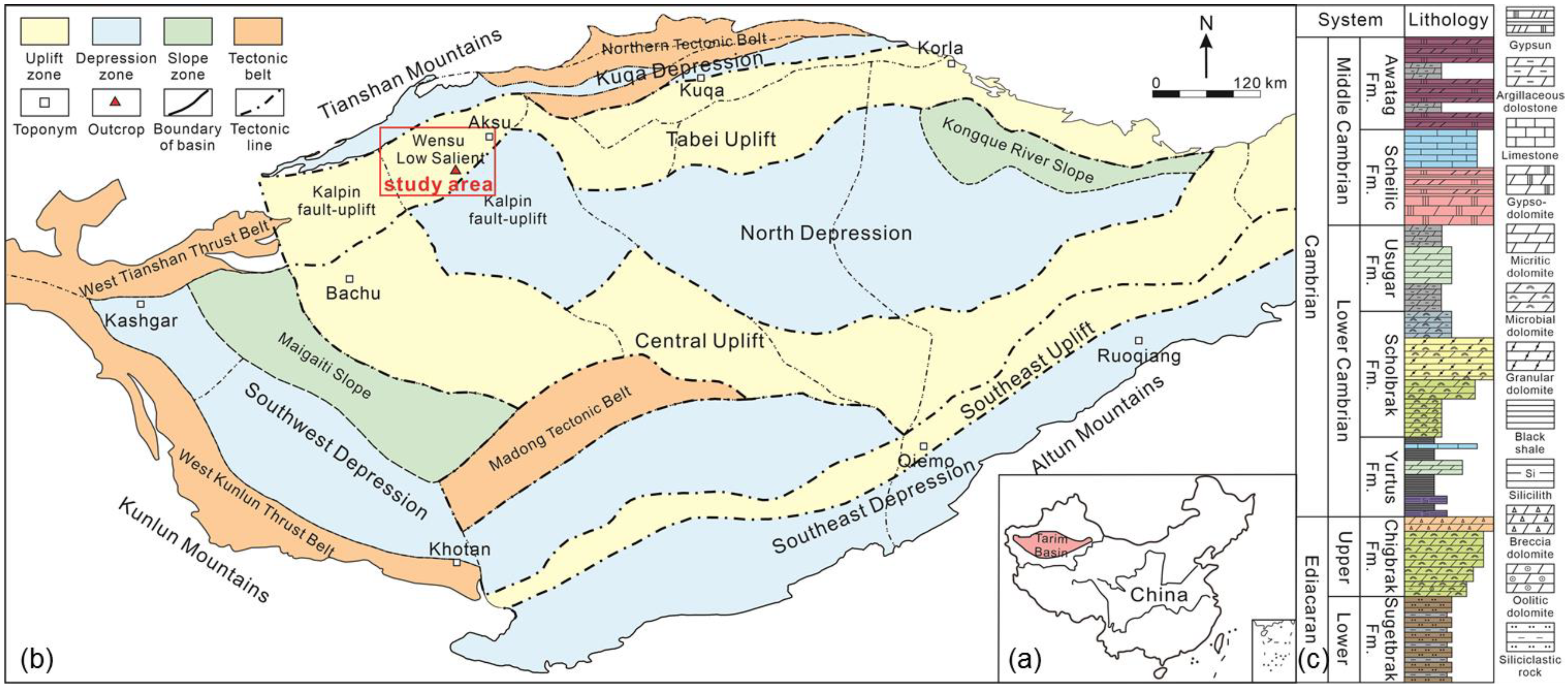

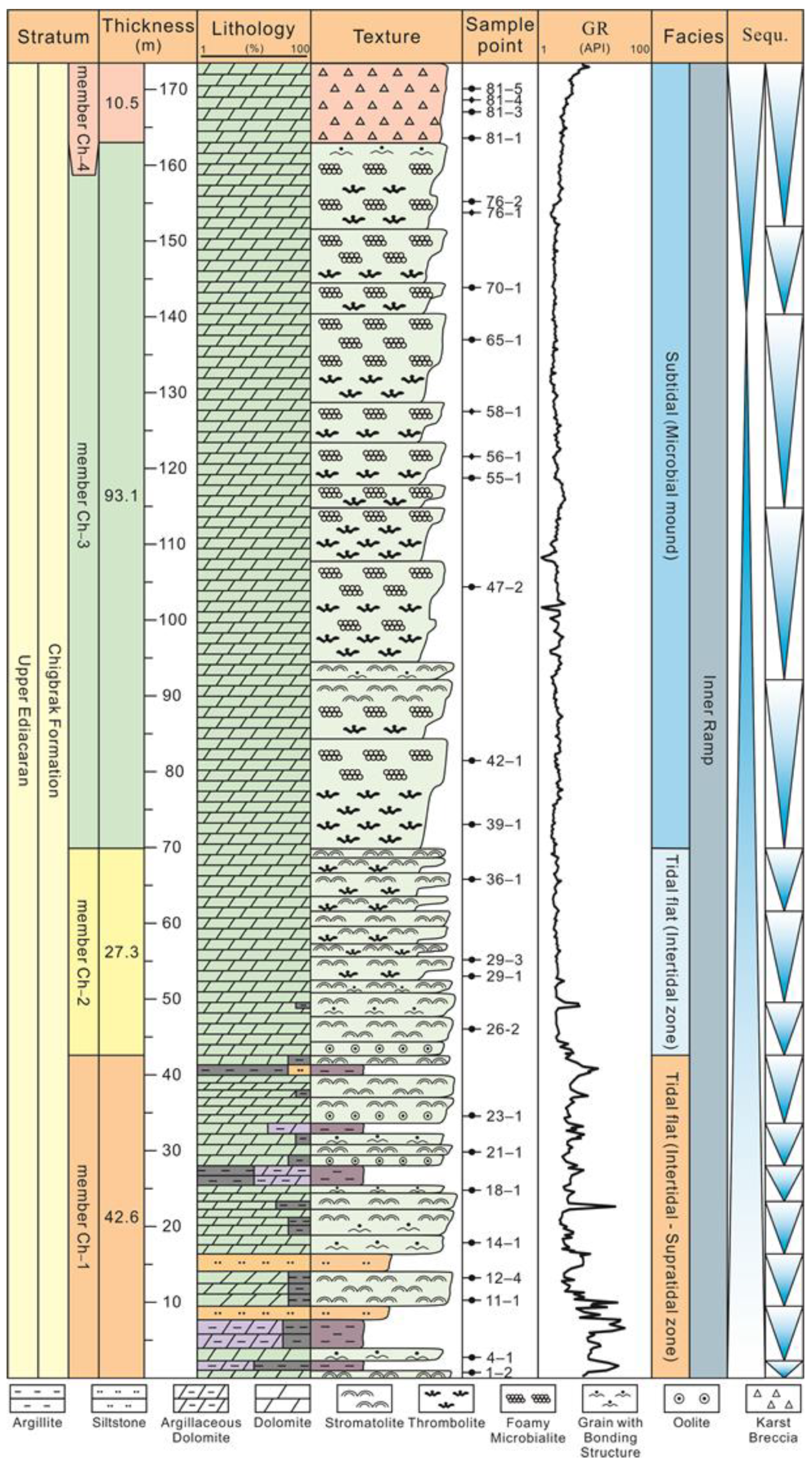
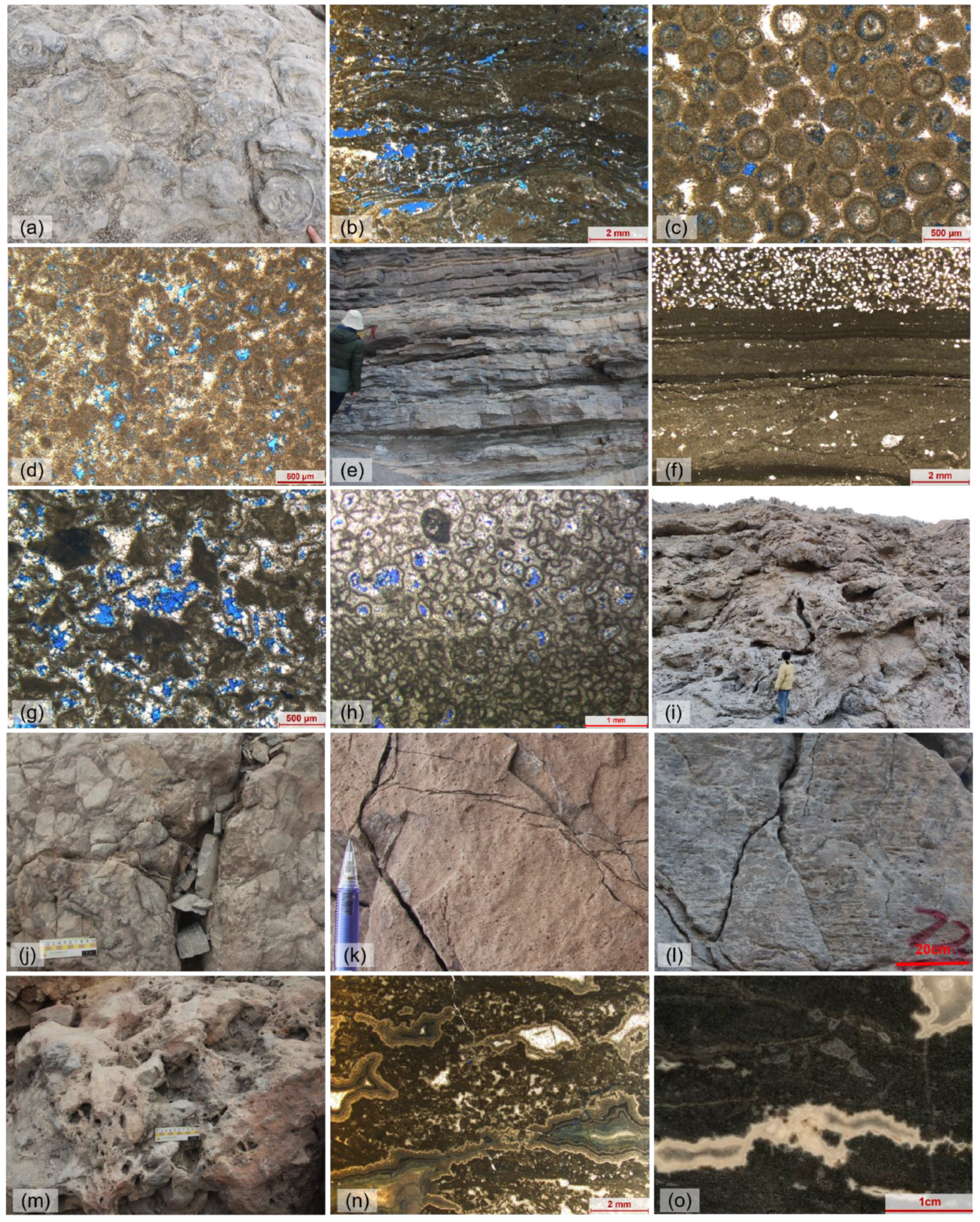



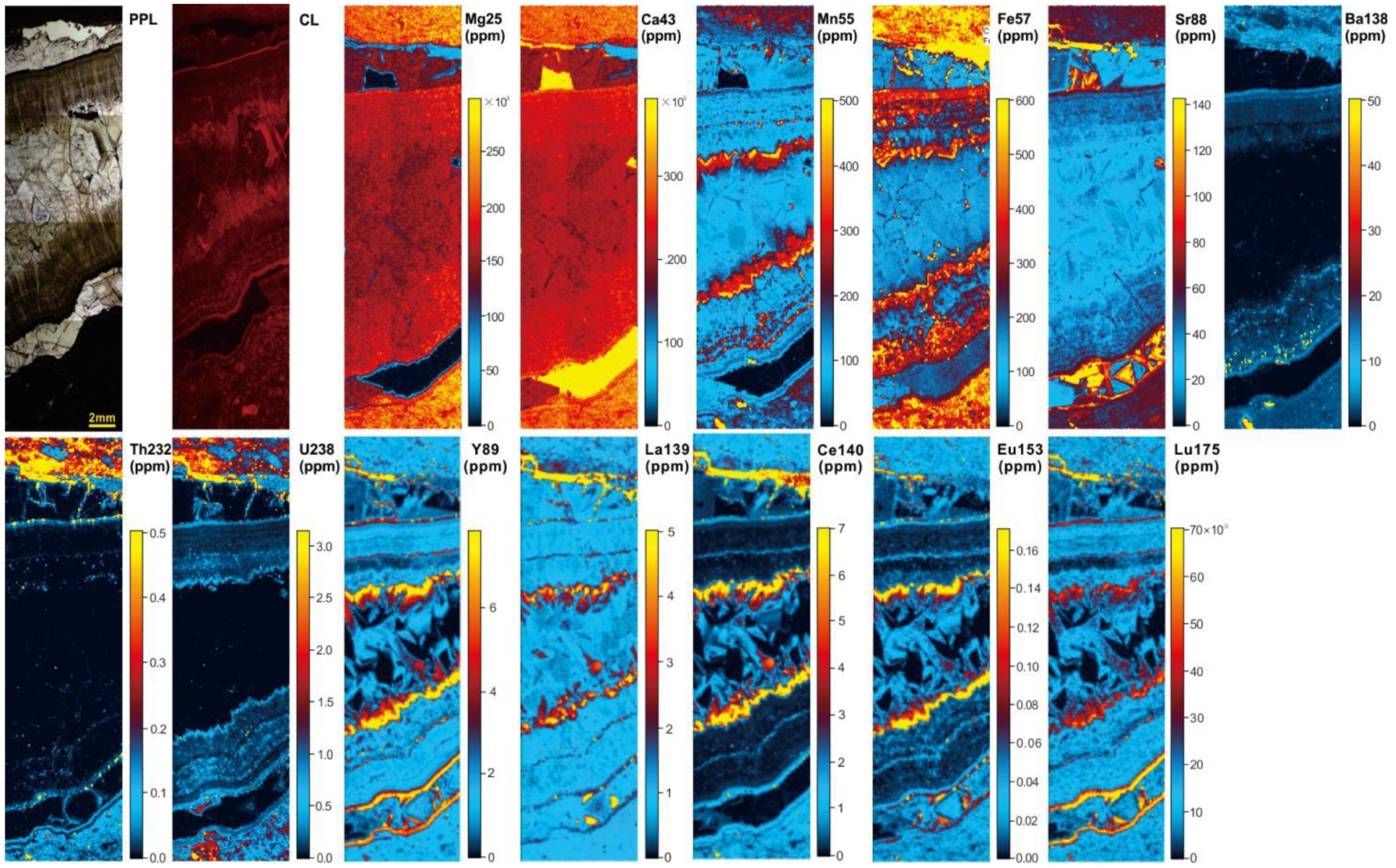
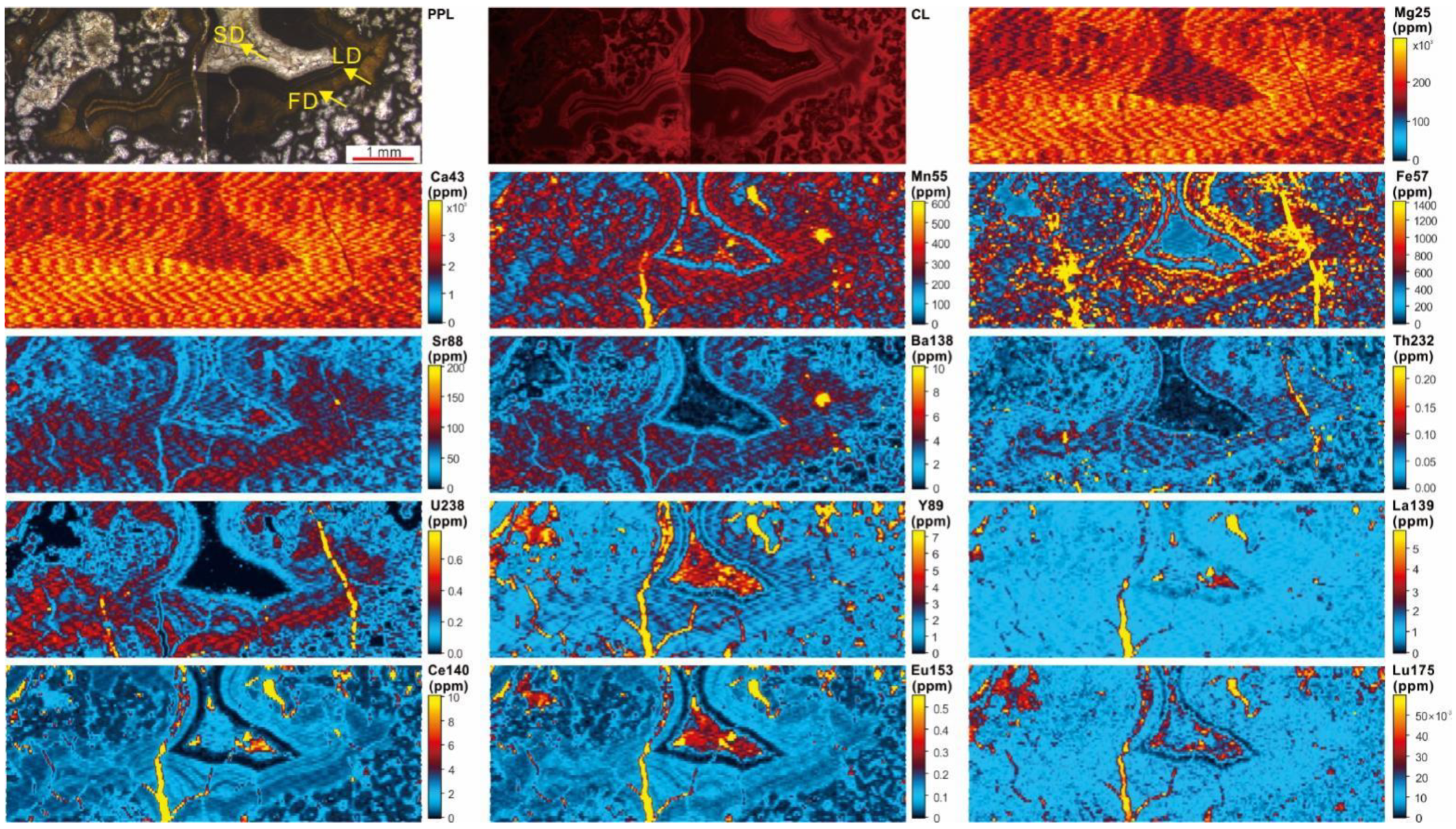

| Sample | Member | Fabrics | δ13C ‰ (PDB) | δ18O ‰ (PDB) | 87Sr/86Sr | U–Pb Age Ma |
|---|---|---|---|---|---|---|
| 56–1 | Ch–3 | ① Dolomitic Microbialite (MD) | 1.87 | −4.26 | 0.70885 | / |
| ② Fibrous dolomite in the pore (FD) | 2.40 | −4.81 | 0.70880 | / | ||
| ③ Granular dolomite in the pore (GD) | 2.28 | −7.34 | 0.70893 | / | ||
| 58–1 | Ch–3 | ①Dolomitic Microbialite (MD) | 2.21 | −4.73 | 0.70882 | 605.4 ± 6.9 |
| ② Fibrous dolomite in the pore (FD) | 2.46 | −5.08 | 0.70871 | 576 ± 17 | ||
| ③ Bladed dolomite in the pore (BD) | 1.59 | −6.61 | 0.70895 | 553 ± 20 | ||
| ④ Granular dolomite in the pore (GD) | 0.95 | −7.86 | 0.70902 | 538 ± 25 | ||
| 76–1 | Ch–3 | ① Dolomitic Microbialite (MD) | 2.69 | −4.29 | 0.70877 | 618 ± 37 |
| ② Fibrous dolomite in the pore (FD) | 2.12 | −5.57 | 0.70876 | 558 ± 26 | ||
| ③ Laminated dolomite in the pore (LD) | 2.83 | −4.90 | 0.70894 | 559 ± 22 | ||
| ④ Saddle dolomite in the pore (SD) | 2.01 | −10.39 | 0.70925 | 256 ± 12 | ||
| 81–4 | Ch–4 | ① Dolomitic Microbialite (MD) | 3.33 | −3.95 | 0.70889 | 538 ± 28 |
| ② Granular dolomite in the pore (GD) | 1.09 | −8.14 | 0.70913 | 513 ± 20 | ||
| ③ Saddle dolomite in the pore (SD) | 1.95 | −9.87 | 0.70948 | 172.9 ± 3.9 |
| Sample | Lithofacies | Member | δ13C ‰ (PDB) | δ18O ‰ (PDB) | 87Sr/86Sr | Ordering Degree |
|---|---|---|---|---|---|---|
| 1–2 | Dolomitic Stromatolite (SD) | Ch–1 | 5.86 | −2.67 | 0.709992 | 0.68 |
| 4–1 | Dolomitic Grainstone with clay (GDC) | Ch–1 | 6.18 | −2.71 | 0.710758 | 0.62 |
| 11–1 | Dolomitic Stromatolite (SD) | Ch–1 | 5.34 | −3.05 | 0.709634 | 0.61 |
| 12–4 | Dolomitic Stromatolite (SD) | Ch–1 | 6.65 | −4.06 | 0.709334 | 0.67 |
| 14–1 | Dolomitic Grainstone with bonding structure (GDBS) | Ch–1 | 5.93 | −2.20 | 0.709359 | 0.60 |
| 18–1 | Dolomitic Grainstone with bonding structure (GDBS) | Ch–1 | 4.49 | −2.55 | 0.709877 | 0.62 |
| 21–1 | Dolomitic Stromatolite (SD) | Ch–1 | 5.35 | −1.23 | 0.710885 | 0.66 |
| 23–1 | Dolomitic Oolite (OD) | Ch–1 | 4.21 | −1.99 | 0.710710 | 0.64 |
| 26–2 | Dolomitic Stromatolite (SD) | Ch–2 | 2.89 | −1.44 | 0.709242 | 0.63 |
| 29–1 | Dolomitic Thrombolite (TD) | Ch–2 | 2.21 | −1.39 | 0.709077 | 0.68 |
| 29–3 | Dolomitic Stromatolite (SD) | Ch–2 | 2.35 | −2.23 | 0.709059 | 0.70 |
| 36–1 | Dolomitic Stromatolite (SD) | Ch–2 | 2.17 | −1.98 | 0.708906 | 0.70 |
| 39–1 | Dolomitic Thrombolite (TD) | Ch–3 | 2.64 | −2.03 | 0.708745 | 0.67 |
| 42–1 | Dolomitic Foamy Microbialite (FMD) | Ch–3 | 3.03 | −4.45 | 0.709093 | 0.68 |
| 47–2 | Dolomitic Foamy Microbialite (FMD) | Ch–3 | 3.48 | −2.65 | 0.709214 | 0.71 |
| 55–1 | Dolomitic Thrombolite (TD) | Ch–3 | 2.15 | −2.46 | 0.709086 | 0.67 |
| 65–1 | Dolomitic Foamy Microbialite (FMD) | Ch–3 | 1.95 | −4.81 | 0.709015 | 0.69 |
| 70–1 | Dolomitic Foamy Microbialite (FMD) | Ch–3 | 1.68 | −4.40 | 0.709178 | 0.70 |
| 76–2 | Dolomitic Foamy Microbialite (FMD) | Ch–3 | 2.65 | −3.67 | 0.709097 | 0.71 |
| 81–1 | Brecciated Dolomitic Thrombolite (BTD) | Ch–4 | 2.09 | −4.33 | 0.709132 | 0.73 |
| 81–3 | Brecciated Dolomitic Foamy Microbialite (BFMD) | Ch–4 | 1.31 | −4.65 | 0.709419 | 0.73 |
| 81–5 | Brecciated Dolomitic Thrombolite (BTD) | Ch–4 | 2.40 | −4.05 | 0.709241 | 0.77 |
| Sample | La (ppm) | Ce (ppm) | Pr (ppm) | Nd (ppm) | Sm (ppm) | Eu (ppm) | Gd (ppm) | Tb (ppm) | Dy (ppm) | Ho (ppm) | Er (ppm) | Tm (ppm) | Yb (ppm) | Lu (ppm) | ΣREEs (ppm) |
|---|---|---|---|---|---|---|---|---|---|---|---|---|---|---|---|
| 1–2 | 4.037 | 8.303 | 0.985 | 3.746 | 0.730 | 0.188 | 0.665 | 0.100 | 0.562 | 0.108 | 0.304 | 0.044 | 0.283 | 0.043 | 20.10 |
| 4–1 | 3.265 | 6.807 | 0.755 | 2.795 | 0.513 | 0.107 | 0.478 | 0.076 | 0.465 | 0.101 | 0.305 | 0.046 | 0.299 | 0.045 | 16.06 |
| 11–1 | 3.746 | 8.640 | 1.168 | 4.559 | 0.882 | 0.204 | 0.851 | 0.138 | 0.843 | 0.178 | 0.520 | 0.075 | 0.467 | 0.070 | 22.34 |
| 12–4 | 2.039 | 4.773 | 0.525 | 1.898 | 0.335 | 0.086 | 0.310 | 0.048 | 0.279 | 0.055 | 0.153 | 0.021 | 0.127 | 0.018 | 10.67 |
| 14–1 | 3.805 | 8.594 | 0.922 | 3.288 | 0.629 | 0.132 | 0.568 | 0.094 | 0.571 | 0.117 | 0.344 | 0.050 | 0.318 | 0.045 | 19.48 |
| 18–1 | 0.842 | 1.631 | 0.224 | 0.829 | 0.162 | 0.051 | 0.176 | 0.030 | 0.186 | 0.040 | 0.112 | 0.017 | 0.108 | 0.017 | 4.43 |
| 21–1 | 0.598 | 1.188 | 0.147 | 0.501 | 0.099 | 0.029 | 0.089 | 0.014 | 0.086 | 0.018 | 0.051 | 0.008 | 0.047 | 0.007 | 2.88 |
| 23–1 | 1.546 | 3.657 | 0.442 | 1.721 | 0.338 | 0.080 | 0.331 | 0.052 | 0.308 | 0.062 | 0.176 | 0.025 | 0.151 | 0.022 | 8.91 |
| 26–2 | 0.457 | 1.102 | 0.132 | 0.446 | 0.086 | 0.026 | 0.080 | 0.012 | 0.068 | 0.013 | 0.041 | 0.006 | 0.038 | 0.006 | 2.51 |
| 29–1 | 0.300 | 0.770 | 0.089 | 0.327 | 0.058 | 0.017 | 0.053 | 0.008 | 0.046 | 0.008 | 0.025 | 0.003 | 0.021 | 0.003 | 1.73 |
| 29–3 | 0.222 | 0.645 | 0.074 | 0.283 | 0.051 | 0.016 | 0.048 | 0.007 | 0.041 | 0.008 | 0.023 | 0.003 | 0.021 | 0.003 | 1.45 |
| 36–1 | 0.070 | 0.157 | 0.016 | 0.056 | 0.011 | 0.003 | 0.013 | 0.002 | 0.013 | 0.003 | 0.009 | 0.001 | 0.008 | 0.001 | 0.36 |
| 39–1 | 0.199 | 0.437 | 0.041 | 0.155 | 0.031 | 0.008 | 0.032 | 0.005 | 0.033 | 0.007 | 0.024 | 0.004 | 0.021 | 0.003 | 1.00 |
| 42–1 | 0.182 | 0.320 | 0.033 | 0.133 | 0.027 | 0.007 | 0.031 | 0.005 | 0.033 | 0.008 | 0.024 | 0.004 | 0.022 | 0.003 | 0.83 |
| 47–2 | 0.123 | 0.204 | 0.023 | 0.096 | 0.020 | 0.005 | 0.027 | 0.004 | 0.028 | 0.007 | 0.023 | 0.003 | 0.021 | 0.003 | 0.59 |
| 55–1 | 0.218 | 0.360 | 0.045 | 0.182 | 0.036 | 0.011 | 0.045 | 0.007 | 0.045 | 0.011 | 0.034 | 0.005 | 0.031 | 0.004 | 1.03 |
| 65–1 | 0.220 | 0.388 | 0.045 | 0.188 | 0.036 | 0.010 | 0.046 | 0.007 | 0.046 | 0.011 | 0.036 | 0.005 | 0.031 | 0.005 | 1.08 |
| 70–1 | 0.457 | 0.888 | 0.099 | 0.358 | 0.070 | 0.017 | 0.071 | 0.011 | 0.072 | 0.017 | 0.047 | 0.007 | 0.042 | 0.007 | 2.16 |
| 76–2 | 0.159 | 0.228 | 0.030 | 0.121 | 0.026 | 0.006 | 0.027 | 0.006 | 0.033 | 0.009 | 0.030 | 0.005 | 0.029 | 0.005 | 0.71 |
| 81–1 | 7.172 | 8.965 | 1.673 | 7.738 | 1.956 | 0.436 | 2.163 | 0.323 | 1.927 | 0.430 | 1.254 | 0.175 | 1.034 | 0.150 | 35.40 |
| 81–3 | 4.507 | 5.608 | 1.055 | 4.342 | 0.893 | 0.192 | 0.914 | 0.140 | 0.836 | 0.177 | 0.525 | 0.076 | 0.458 | 0.068 | 19.79 |
| 81–5 | 5.326 | 6.711 | 1.238 | 5.465 | 1.284 | 0.283 | 1.385 | 0.208 | 1.242 | 0.272 | 0.798 | 0.112 | 0.670 | 0.098 | 25.09 |
Disclaimer/Publisher’s Note: The statements, opinions and data contained in all publications are solely those of the individual author(s) and contributor(s) and not of MDPI and/or the editor(s). MDPI and/or the editor(s) disclaim responsibility for any injury to people or property resulting from any ideas, methods, instructions or products referred to in the content. |
© 2023 by the authors. Licensee MDPI, Basel, Switzerland. This article is an open access article distributed under the terms and conditions of the Creative Commons Attribution (CC BY) license (https://creativecommons.org/licenses/by/4.0/).
Share and Cite
Zheng, J.; Wang, H.; Shen, A.; Luo, X.; Cheng, Z.; Dai, K. Genesis of Dolomite Reservoir in Ediacaran Chigbrak Formation of Tarim Basin, NW China: Evidence from U–Pb Dating, Isotope and Element Geochemistry. Minerals 2023, 13, 725. https://doi.org/10.3390/min13060725
Zheng J, Wang H, Shen A, Luo X, Cheng Z, Dai K. Genesis of Dolomite Reservoir in Ediacaran Chigbrak Formation of Tarim Basin, NW China: Evidence from U–Pb Dating, Isotope and Element Geochemistry. Minerals. 2023; 13(6):725. https://doi.org/10.3390/min13060725
Chicago/Turabian StyleZheng, Jianfeng, Hui Wang, Anjiang Shen, Xianying Luo, Zhao Cheng, and Kun Dai. 2023. "Genesis of Dolomite Reservoir in Ediacaran Chigbrak Formation of Tarim Basin, NW China: Evidence from U–Pb Dating, Isotope and Element Geochemistry" Minerals 13, no. 6: 725. https://doi.org/10.3390/min13060725
APA StyleZheng, J., Wang, H., Shen, A., Luo, X., Cheng, Z., & Dai, K. (2023). Genesis of Dolomite Reservoir in Ediacaran Chigbrak Formation of Tarim Basin, NW China: Evidence from U–Pb Dating, Isotope and Element Geochemistry. Minerals, 13(6), 725. https://doi.org/10.3390/min13060725








